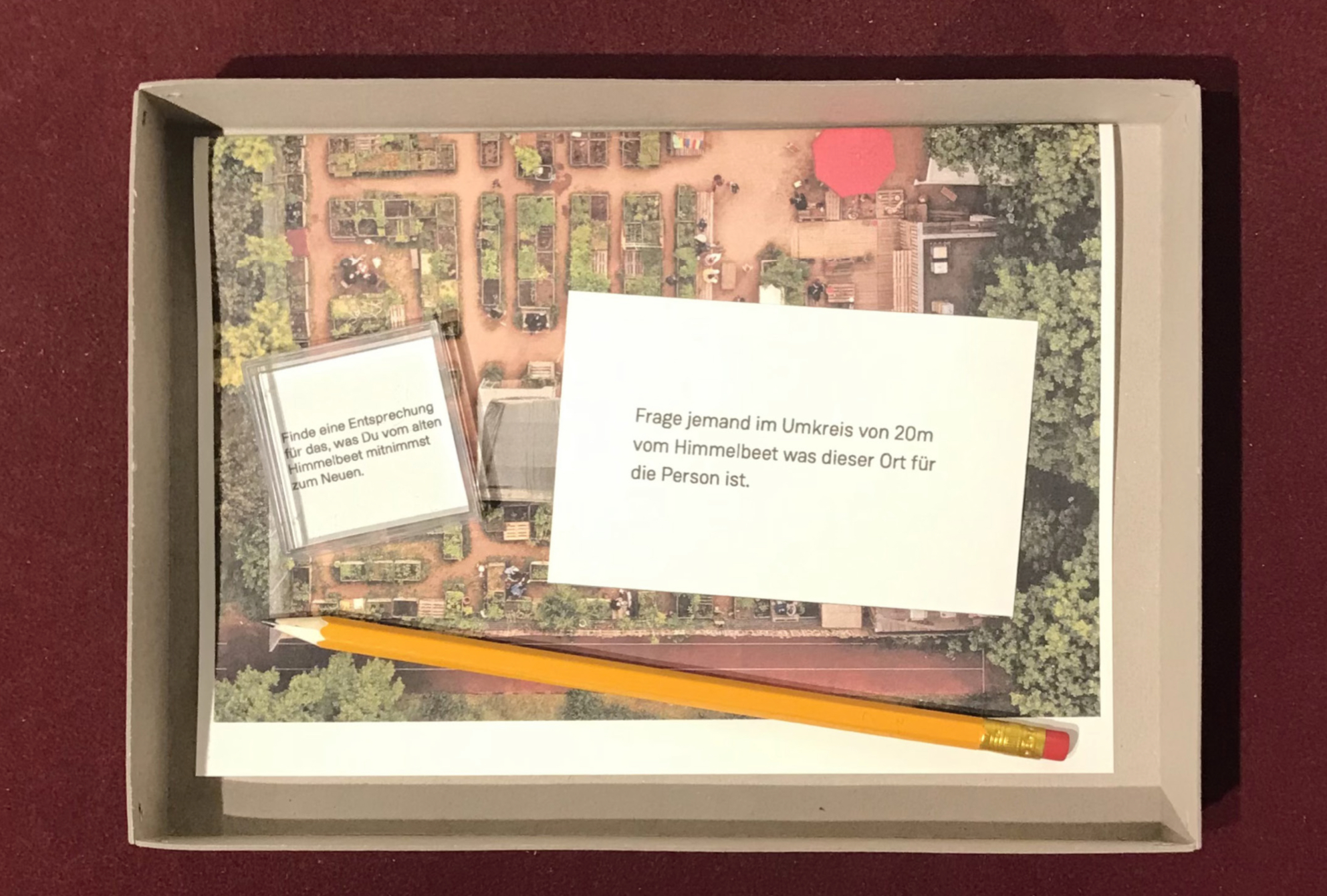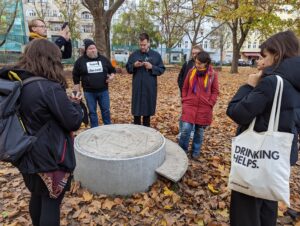Kulturtester
EXPLORATION & KNOWLEDGE SHARING
Culture Tester is a method from Experience Design. It is based on the assumption that places and spaces create their own culture and is based on giving users an understanding of how they experience a space by producing cultural value and meaning for it.
Short summary of the practice
Kulturtester is a method from experience design. It assumes that places and spaces each create their own culture. In order to understand what is important for a community, those spaces can be „tested“ by mapping things which are important for individuals, behavior, traditions and experiences. The Kulturtester method is in this way investigating the experience a group had of any kind of space. In a second step these experiences can be analyzed and reproduced to a certain extent in other spaces.
Goal of the practice
The Kulturtester method is based on giving the users an understanding of how they experience a space by producing cultural value and meaning to it.
Target group
The method is suitable for any group. Still it is usually made for groups 16+ as a certain analytic and conceptual thinking is needed. The group size can be between 5 – 40. More people are involved during the „testing“.
Number of participants: Between 5-40 peoples
Age of participants: Youth and Adults, 16+
Materials
- Map, aerial photo or visualization of the space
- Small boxes
- Pencils
- Cards with the tasks
- Marker
- Flipchart paper
Method settings
The method can be adapted to any city and place.
Duration
The exercises can take up to several hours.

Preparation
The preparation phase can take up to 2 hours.
Step by step guide
The method follows a three-stage process, namely preparation, exploitation, and analysis, to effectively engage the target community.
During the preparation phase, facilitators engage in conversations with community members to gain insights into the relevant scale of exploration. This could vary depending on the community’s preferences, encompassing anything from a city or neighborhood to a park, house, or even a single room.
Once the scale is determined, the next step involves creating a Kulturtester box, which typically includes a photo or map of the area, pencils, and task sheets.The number and nature of tasks can be collaboratively developed with community members or defined by the facilitator. The crucial aspect is to design tasks that encourage exploration of various dimensions, procedures, events, and experiences that contribute to the local culture. These boxes are then distributed to community members, who are tasked with completing them within the designated space. This exercise serves to heighten their awareness of the space and helps uncover hidden values that often go unnoticed in their everyday lives.
The results of these activities can take various forms, such as marked places on a map, objects, drawings, and more.Moving on to the analysis or sensemaking phase, the facilitator invites the “collectors” back to a common meeting. During this session, the collected results are shared and discussed. Objects and findings are examined, and a collective brainstorming session takes place to develop a comprehensive culture description, which is then visually represented on a poster. This poster serves as a reference point for participants to initiate discussions about a common path towards local action, create a shared vision for the future, or foster a better understanding among community members to address and mitigate conflicts.
To implement this method, several materials are required, including a map, aerial photo, or visualization of the space to provide a spatial context. Small boxes serve as containers for the Kulturtester materials, while pencils enable participants to complete the tasks. Cards with predefined tasks help guide participants during the exploration process. A marker is essential for visualizing and capturing ideas on flipchart paper, which facilitates collective sensemaking and brainstorming sessions. The amount of tasks and their content can be either co-created with community members or defined by the facilitator. Important is that it stimulates exploring things, procedures, events, experiences to other aspects, exploring a local culture. These boxes will be provided to members of the community, with the task to fulfill them in the space. This allows the facilitator to better understand how the culture is created and the space experienced.
The community members create an awareness of the space and start to realize hidden values, as many times they are in everyday life not aware of the „culture“ they produce. The results should be collected (it can be placed on a map, objects, drawings etc.).
In the analysis or sensemaking phase, the facilitator is inviting the „collectors“ back to a common meeting. Here the results will be discussed, the objects shared and through a collective brainstorming a common culture description created on a poster. The poster can help the participants to start to discuss a common path towards local action, a common vision of the future or to create a better common understanding to mitigate conflicts.
Expected output
The results are a collection of cultural representations, which help to create a common understanding of the space. Based on this and depending on the aim, various results can be created. It might be a simple visualization of the objects, but it can be as well action plans, mitigation strategies or future scenarios. The facilitator should make sure to be aware, which results are most beneficial.
Change the method brings to the communities
The Kulturtester method is based on giving the users an understanding of how they experience a space by producing cultural value and meaning to it. Still, the size of the space might vary.
The aim is not to provide a clear, ultimate answer on what is there, but to let individuals or a group reflect on it. This results usually in a first step on a better understanding of a space. Understanding the value or what exactly is the value, helps the group to create actual change in the physical environment. Depending on what is needed the method helps to discuss future scenarios by connecting a possible future to the local „cultural“ heritage. The scenarios could be turned into action plans, leading to concrete actions in the community. As the method is designed to bring people together around common experiences, it can be used as well to mitigate conflicts on space usages or competition on social space, like it happens during gentrification.
A good example of how this impact can be reached is included with all three aspects in the work with the urban garden. The staff got aware of what they want and what not, implementing a new vision for the future garden, while going into the neighborhood and mapping their culture, behaviors, traditions and addressing those into their future scenario, preventing potential conflicts on using social, public space from the beginning.
Adaptation/Application of the method
This method can be applied in various contexts where there is a need to engage a community in understanding and exploring their local culture and space.
Potential application areas are:
- Community Development Projects: The kulturtester can be used in community development initiatives to involve residents in understanding and appreciating the cultural and spatial aspects of their neighborhood or community. It can help foster a sense of ownership, pride, and collective responsibility towards the local environment.
- Urban planners and designers can employ this method to engage stakeholders in the process of shaping their urban environment. It allows community members to actively participate in decision-making processes, voice their opinions, and contribute to the creation of a more inclusive and sustainable urban landscape.
- Education and Learning: The method can be utilized in educational settings, such as schools and universities, to promote experiential learning and a deeper understanding of local culture and history. It encourages students to actively engage with their surroundings and fosters critical thinking, creativity, and collaboration.
- Social Integration and Inclusion: In contexts with diverse communities, this method can help bridge gaps and promote social integration. By involving individuals from different backgrounds in exploring and appreciating their shared cultural spaces, it can foster dialogue, understanding, and a sense of belonging among community members.
Credit, References, and Resources
See projects of Comparative Research Network – http://www.crnonline.de
Related posts

Active Citizenship
Active citizenship in this context refers to the power of individuals or small resident groups to proactively engage in community mapping exercises for improving their city or neighborhood.

ArcGIS Online
ArcGIS Online provides a cloud-based mapping and analysis solution. It is used to create interactive web maps, analyse data, share and collaborate.

Civic Alert
Civic Alert is a platform designed to facilitate communication between citizens and governments. Citizens can use their mobile application to report problems in the city to the authorities in three easy steps.
